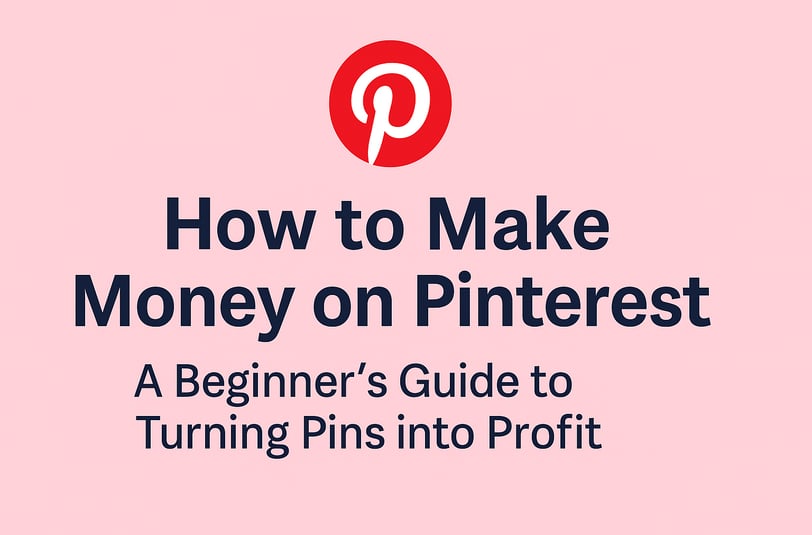How to Make Money on Pinterest: A Beginner’s Guide to Turning Pins into Profit
Learn how to make money on Pinterest with affiliate marketing, digital products, and smart content strategy. This step-by-step guide shows beginners how to grow traffic and earn income using Pinterest.
Adetola Olukoya
5/26/20253 min read


Pinterest isn’t just a place for inspiration — it’s a powerful platform for creators, small businesses, and side hustlers to generate real income. With over 450 million monthly users, Pinterest functions like a visual search engine, making it a prime opportunity to grow traffic, promote products, and build a brand that earns.
At Capital and Budget, we’re all about helping you take control of your finances and find smart ways to increase your income. Whether you're looking for a passive income stream or want to grow your online business, here’s how you can start making money on Pinterest.
1. Start with a Clear Niche and Strategy
Success on Pinterest starts with clarity. Are you promoting budget printables, digital products, affiliate links, or blog content? Choose a niche that aligns with your passion and expertise — personal finance, DIY, productivity, wellness, etc.
Your Pinterest strategy should include:
A branded profile with keywords in your bio
Niche-specific boards (e.g., Budgeting Tips, Money Saving Hacks)
High-quality, clickable pins with clear calls to action
2. Use Pinterest to Drive Traffic to Monetized Content
Pinterest isn’t where transactions happen — it's where attention starts. Your goal is to direct users from your pins to your:
Blog posts with display ads or affiliate links
Product pages (e.g., Etsy, Shopify, Gumroad)
Email opt-ins that lead to product funnels
If you're using a blog like Capital and Budget, you can share helpful content (like budgeting tips or finance checklists) and use Pinterest to consistently drive traffic to that content.
3. Monetize with Affiliate Marketing
Pinterest allows direct affiliate links, making it an ideal platform for affiliate marketing. You can earn commissions by promoting products or tools you believe in.
How to do it:
Join affiliate programs (Amazon Associates, ShareASale, Impact)
Create pins that review or recommend specific products
Add your affiliate link directly to the pin or blog post
Pro Tip: Use a disclosure (e.g., “This post contains affiliate links”) to stay compliant with FTC guidelines.
4. Create and Sell Digital Products
If you have a skill — like designing templates, planners, or budget sheets — Pinterest is a perfect place to market those products.
Examples:
Budgeting printables
Ebooks or finance guides
Canva templates
Online courses or workshops
Design pins that show your product in use, and link them to your shop or landing page. A single viral pin can lead to hundreds of sales.
5. Join the Pinterest Creator Rewards (U.S. Only for Now)
Pinterest has tested its Creator Rewards and Idea Pin monetization features. While still in limited rollout, these programs reward creators for high-performing content based on specific engagement goals.
Even without direct rewards, consistent, high-quality content builds your visibility — and leads to more clicks, traffic, and sales.
6. Optimize Your Pins for SEO
Pinterest is a search engine. Your success depends on using strong keywords in:
Pin titles
Descriptions
Alt text
Board names
Use tools like Pinterest Trends or Ubersuggest to find keywords your audience is searching for, such as “budget planner printable” or “side hustle ideas.”
7. Be Consistent and Use Scheduling Tools
To grow on Pinterest, consistency matters. Aim to post 5–10 pins per day (including re-pins and fresh content). Tools like Tailwind or Pinterest’s native scheduler make this easier.
Batch-create pins and set them to publish throughout the week. Over time, consistent pinning builds momentum — and earnings.
Final Thoughts
Pinterest isn’t a get-rich-quick platform — but it is a sustainable way to generate income if you approach it with the right strategy. From affiliate links and digital products to growing a blog like Capital and Budget, Pinterest can be the launchpad to a profitable online presence.
The best part? You don’t need a huge following to start. Just valuable content, visually engaging pins, and a focus on helping your audience.
Ready to turn your Pinterest boards into a business?
Start by sharing your favorite budgeting tool or money-saving tip on Pinterest — and watch the traffic grow.
Author
Adetola Olukoya
Adetola Olukoya is the founder of Capital and Budget, a personal finance blog focused on helping everyday people make smarter money decisions. With a background in tech and a passion for financial literacy, Adetola shares simple, actionable tips to help you grow your financial confidence.